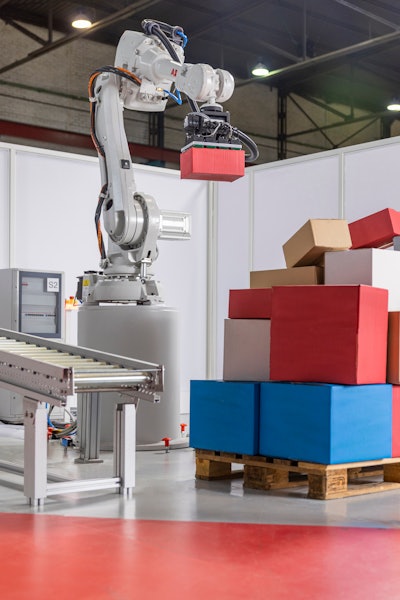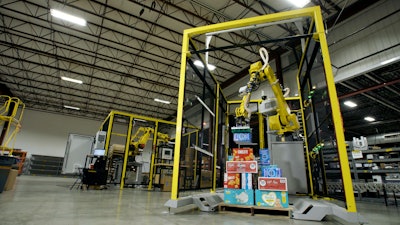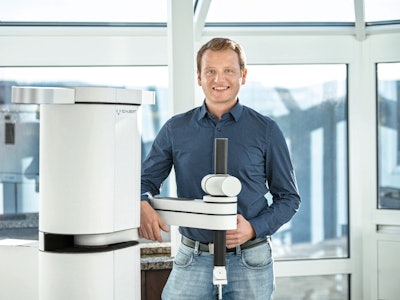New robotic technologies under the artificial intelligence umbrella make make it possible to now automate complex packaging tasks.
In a new report from PMMI – The Association for Packaging and Processing Technologies, titled, “2022 Robots and Cobots An Automated Future,” CPGs and OEMs said they believe the top three improvements in robotic functionality that will have the greatest impact in the next five years and that will influence OEM applications, respectively, are AI, machine learning, and vision, all of which are rooted in AI applications. According to the report, AI’s use in packaging is predicted to grow at a CAGR of over 50% for the next five years.
Says PMMI, “AI and machine learning have been key developments in robotics that are continually expanding the realm of possibility for robot applications. Closely intertwined, AI and machine learning allow robots to adapt to new scenarios by building on a constantly increasing volume of relevant data. These technologies have opened up a world of complicated tasks for robots, from dynamically picking items the robot has never encountered before to rapidly and accurately inspecting incoming and outgoing products on a line.”
Interviewed for the report, an advanced manufacturing manager from an SME household company, said, “Both AI and self-learning will be huge to manage mixed pallets and make corrections on the fly.”
Regarding advancements in vision, a director of sales and marketing for an OEM said, “Vision has come a long way in the past few years, with 3D vision. Continued improvements to vision functionality will be key.” The ABB Robotics Depalletizer uses machine vision software to master complex depalletizing tasks.One solution that incorporates machine vision software to master complex depalletizing tasks in the logistics, e-commerce, healthcare, and CPG industries is ABB Robotics’ new ABB Robotic Depalletizer, designed to replace heavy manual lifting and improve efficiency. The depalletizer is equipped with ABB four- or six-axis robots and ABB’s RobotStudio digital twin software, which allows customers to build tailored solutions to process assorted loads with very little engineering effort and a short setup time.
The ABB Robotics Depalletizer uses machine vision software to master complex depalletizing tasks.One solution that incorporates machine vision software to master complex depalletizing tasks in the logistics, e-commerce, healthcare, and CPG industries is ABB Robotics’ new ABB Robotic Depalletizer, designed to replace heavy manual lifting and improve efficiency. The depalletizer is equipped with ABB four- or six-axis robots and ABB’s RobotStudio digital twin software, which allows customers to build tailored solutions to process assorted loads with very little engineering effort and a short setup time.
Says ABB, not only are depalletizing tasks growing more complex as the composition and configuration of pallets becomes more varied, but these previously manual sorting jobs are typically characterized by high staff turnover and increased recruitment costs. “ABB’s Robotic Depalletizer solves these problems by using advanced machine vision and machine learning algorithms to quickly and efficiently process pallets of up to 2.8 meters high, the only solution currently capable of operating at these heights,” the company shares.
The robotic depalletizer software uses the information gathered by the vision sensor to provide the robot with a suitable grasping point for each box. The robot then picks up the box—weighing up to 30 kg—and places it on either another pallet or an outfeed conveyor. The system can operate at a peak rate of up to 650 cycles/hr, 24 hr/day.
The vision sensor enables the robot to detect specific boxes on pallets, allowing depalletizing of several different load types. These include pallets comprised of a single type of box in defined layers; “rainbow” pallets containing a number of different box types; and mixed pallets, which have a wide range of boxes with varying weights, shapes, and materials.
Similarly designed to handle mixed-case palletizing, depalletizing, and decanting applications using AI is a solution demonstrated by Applied Manufacturing Technologies (AMT) at Automate 2022. Using a Fanuc CRX-10iA cobot and a Schmalz FXCB vacuum gripping end-of-arm tool (EOAT), the robotic cell displayed delayering and tote filling using defined box and tote parameters to optimize the tote fill and solve the entire layer.
Says AMT, Schmalz’s FXCB vacuum gripping solution integrates a vacuum generator, flow resistors, and a digital pressure switch into a compact and lightweight design, while vision software from AMT partner Liberty Reach uses the best-fit finding-and-use algorithms to optimize the pick solution for reduced cycle time overall. Explains the company, an optimized cycle includes picking multiple cases to load the tote. If a multi-pick solution is not available, the algorithm selects the next best position to allow the robot to pick a case.  Pearson employ’s Pick One’s AI-driven software to enable its robotic depalletizer to pick randomized cases, cartons, trays, or bags.Also offering a new robotic depalletizing solution for warehouse, e-commerce, fulfillment, and distribution applications is Pearson Packaging Systems. The company is using Plus One’s AI-powered PickOne vision system in conjunction with a remote human supervision tool called Yonder to enable its depalletizers to pick randomized cases, cartons, trays, or bags, even if they are overlapping or overhanging.
Pearson employ’s Pick One’s AI-driven software to enable its robotic depalletizer to pick randomized cases, cartons, trays, or bags.Also offering a new robotic depalletizing solution for warehouse, e-commerce, fulfillment, and distribution applications is Pearson Packaging Systems. The company is using Plus One’s AI-powered PickOne vision system in conjunction with a remote human supervision tool called Yonder to enable its depalletizers to pick randomized cases, cartons, trays, or bags, even if they are overlapping or overhanging.
The system uses 3D cameras to identify the 3D geometric surfaces, edges, and corners of products and determine size, shape, height, and location in real time. PickOne’s perception kit then scans a pallet stack to identify pickable items and assigns each one a confidence level, after which the software sends the pick location for each recognizable item to the robot controller via the PickOne API (Application Programming Interface). If confidence levels are insufficient for a reliable pick, the software automatically generates a Yonder request, triggering remote human intervention. With a response time of under 6 sec, a remote robot controller handles the exception by manually selecting an item and its pick point. In parallel, Yonder stores the responses to facilitate ongoing machine learning and increased efficiencies over time.  Shape Process Automation (SPA) and Mujin demonstrated a mixed-case depalletizing and palletizing solution at Automate 2022.At the Automate show in June 2022, robotic systems integrator Shape Process Automation (SPA) and robotics technology company Mujin demonstrated a mixed-case depalletizing and palletizing solution driven by Mujin’s intelligent robotics platform. SPA is an integrator for a number of robotic manufacturers, including Fanuc, whose robot arm is one of several brands compatible with Mujin’s flagship product, the MujinController. To facilitate mixed-case depalletizing and palletizing applications, the controller uses machine intelligence, which SPA explains is a type of AI that automatically manages potential downtime scenarios through perception, autonomous decision making, and real-time motion planning without the need for human intervention.
Shape Process Automation (SPA) and Mujin demonstrated a mixed-case depalletizing and palletizing solution at Automate 2022.At the Automate show in June 2022, robotic systems integrator Shape Process Automation (SPA) and robotics technology company Mujin demonstrated a mixed-case depalletizing and palletizing solution driven by Mujin’s intelligent robotics platform. SPA is an integrator for a number of robotic manufacturers, including Fanuc, whose robot arm is one of several brands compatible with Mujin’s flagship product, the MujinController. To facilitate mixed-case depalletizing and palletizing applications, the controller uses machine intelligence, which SPA explains is a type of AI that automatically manages potential downtime scenarios through perception, autonomous decision making, and real-time motion planning without the need for human intervention.
Ross Diankov, co-founder of Mujin, says he expects immediate benefits for joint customers struggling to automate labor-intensive depalletizing and palletizing applications, among others: “SPA’s experience and reputation in deploying robotics automation solutions make them an ideal fit as Mujin seeks to empower the North American logistics market with Mujin’s revolutionary machine intelligence. Together, we can accelerate a new wave of robotics technology in the U.S. and help to advance the vision of a completely autonomous warehouse.” Schubert’s new AI-driven tog.519 cobot has been designed for pick-and-place tasks and for separating lightweight product at 80 cycles/min.Another robot application now driven by AI is one from Gerhard Schubert GmbH called the tog.519 cobot, “tog” meaning together, but this one for pick-and-place tasks and for separating lightweight products. Says the company, “On its own, a cobot cannot solve a packaging task. Many of them are too slow and cannot be stopped safely at high speeds or when in contact with a human.” For example, it explains, a typical pick-and-place task might involve placing pouches in a cartoner chain. “This would otherwise require one or two people to take the pouches out of the box and place them in the chain,” it says. “The tog.519 recognizes the pouches even if they are lying one on top of another, and identifies the chain pitches in which to place them.”
Schubert’s new AI-driven tog.519 cobot has been designed for pick-and-place tasks and for separating lightweight product at 80 cycles/min.Another robot application now driven by AI is one from Gerhard Schubert GmbH called the tog.519 cobot, “tog” meaning together, but this one for pick-and-place tasks and for separating lightweight products. Says the company, “On its own, a cobot cannot solve a packaging task. Many of them are too slow and cannot be stopped safely at high speeds or when in contact with a human.” For example, it explains, a typical pick-and-place task might involve placing pouches in a cartoner chain. “This would otherwise require one or two people to take the pouches out of the box and place them in the chain,” it says. “The tog.519 recognizes the pouches even if they are lying one on top of another, and identifies the chain pitches in which to place them.”
The cobot offers an output of 80 cycles/min and can handle product weights to 700 g. The high cycle rate, Schubert explains, is only possible through image processing based on a neural network with AI. “All it takes is a handful of pictures and a few days for the AI to learn new products on its own without programming,” the company says.
To ensure speed throughout, the tog can operate in a protective cell in small spaces. However, it can also be operated without a protective cage while still providing a high level of safety. As a freestanding cobot, it reacts to people in its environment and slows down when necessary.
Possible applications for the tog.519 are fast feeding at the machine, kit assembly, where various product parts are put together to form a set, or product finishing. A complete modular cobot includes five-axis SCARA kinematics, a vision system, feed belts, a safety module, and more. Schubert’s goal is to develop a whole family of togs based on a modular construction kit.